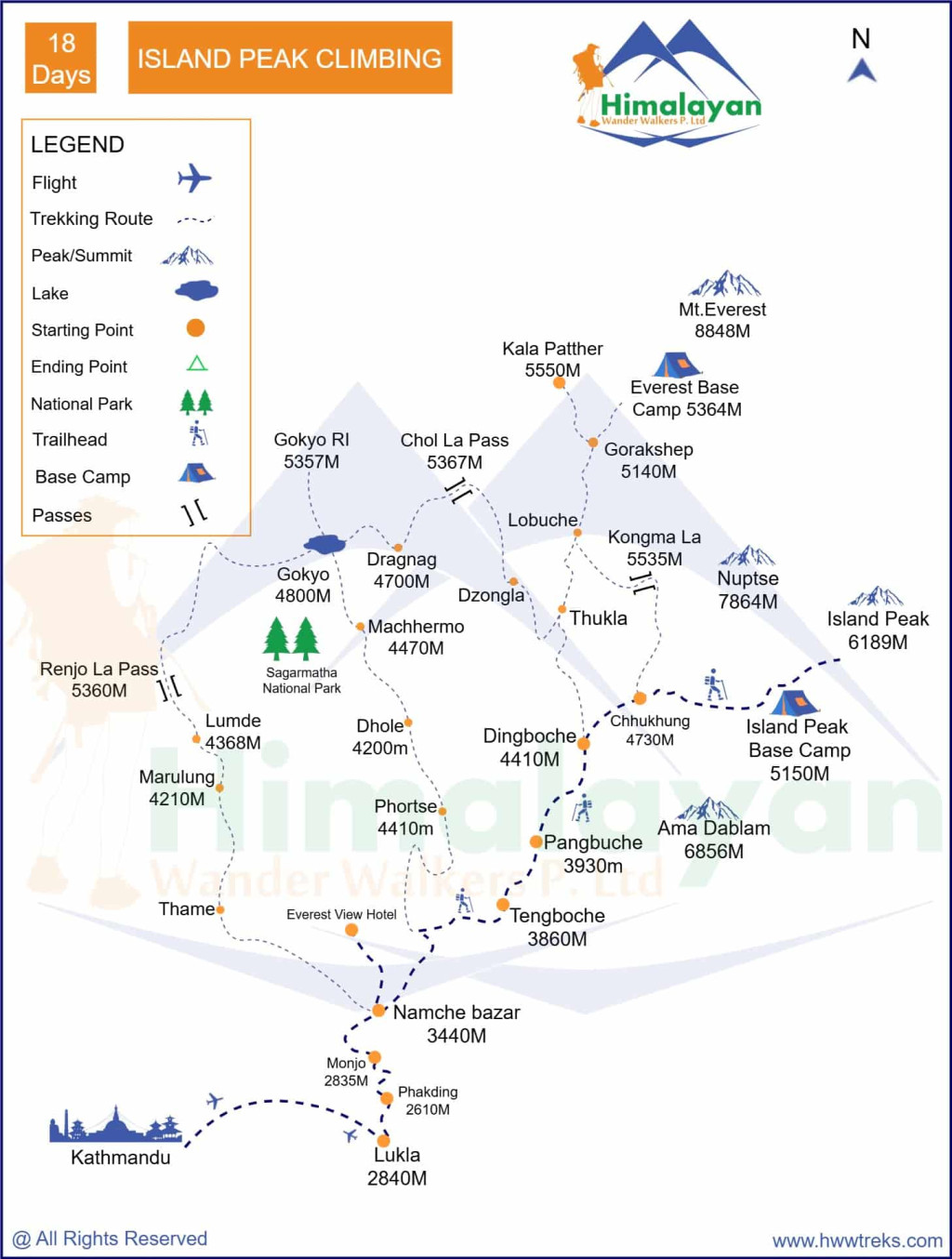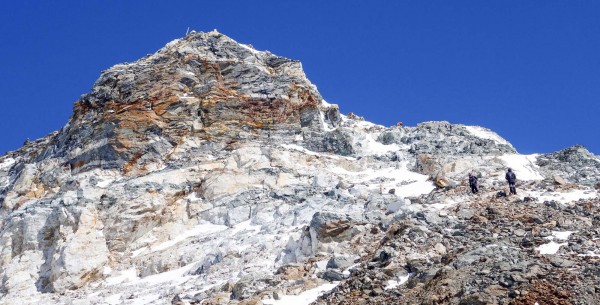Important Information
Region
Peak climbing and Expedition
Duration
15 Days
Max Altitude 6189 meters
Best Season April-June & October - November
Grade
Level 3
Group Size
2 - 8 people
Transportation 2 way Flight
Imja Tse, Island Peak (6160m) is the best trekking peak in the Everest region for novice climbers to develop the skills of climbing on snow and ice at high altitudes.
Island Peak is the number one rating climbing peak in the Everest Region of Nepal which has (6,189m/20,305ft) heights. It is also known as Imja Tse. It is the extension of Lhotse Shar which is very popular for trekking trails that can be reached crossing Everest Base Camp. The name of the peak is Island because it is located on the top of Chhukung Glacier, the peak is very challenging to climb but it is rated ‘moderate’; and although a good level of physical fitness is essential, previous climbing experience is not required. From Dingboche, the Himalayas, and Island Peak are seen as a pyramid of ice and rock. The Himalayan ridge rising to the south from this point leads to the summit of Island Peak.
Island Peak Climbing and Trekking duration provides not only an enjoyable climb but also some of the most jaw-dropping scenery of the Himalayas in the Khumbu region which are the giant mountains, Nuptse (7,879m), Lhotse (8,501m), Lhotse Middle Peak (8,410m) and Lhotse Shar (8,383m) make a semi-circle in the north. One can see the views of Makalu (8475m) in the east, and Baruntse and Ama Dablam in the south. Island Peak Climbing has provided many more opportunities of viewing the Giant Himalayas and peaks of the Everest Region.
If you are not experienced in climbing don’t worry we are here for you. Our well-experienced climbing guides will support and guide you in all situations during your summit and trekking. It is well said that every mountain top is within reach if you just keep climbing. Please don’t hesitate to contact us for more information regarding this trek and climbing.
Why Imja Tse is called Island Peak?
The original name is Imja Tse in the Sherpa language and still, they call it Imja Tse. This peak is surrounded by icy mountains which appear as an island in the middle of the glaciers when you look from the Dingboche village of Khumbu Region. Later in 1953, Imja Tse was named Island Peak by members of the British Mount Everest expedition. So, Island Peak became more familiar with the mountaineering industry.
If you are looking for a different itinerary than the one here, please Customize Your Trip.
The Highlight of the Trip
- Island Peak Climbing (6189m).
- Wonderful View of the Mt. Everest.
- Cultural Wonders of Everest Region.
- Peaceful yet Adventurous walk all through the trip
- Tengboche and Pangboche monasteries exploration.
*If you are booking for spring season (March, April and May). The given price will increase by USD 175 due to Peak Permit fee higher in season.
Include
Airport/Hotel/Airport transfer
Your standard meals (Breakfast, Lunch, and Dinner) during the trekking.
All Trekking & Climbing permit.
Necessary Trekking, Climbing equipment
Domestic Flight Ticket (Kathmandu to Lukla/ Kathmandu) / domestic airport Tax.
All accommodations in lodges/tea houses during the treks.
An experienced, helpful and friendly Trekking and Climbing Guide, porters
Trek arrangements with tents, cook, and porter/s. NMA Registered Climbing Guide for trek and climbing.
Arrangement of Emergency Helicopter service which will be paid by your Travel insurance company.
Medical supplies (first aid kit will be available).
All government taxes & Service charge.
Exclude
Nepal entry visa and International flight ticket.
Travel insurance.
Lunch dinner in Kathmandu.
Climbing boots.
All Bar bills and personal expenses( phone call, laundry service, battery recharge, a bottle of water, hot water, shower, a pot of tea, coffee, etc
Tips for the guide and porter.
International air ticket
Accommodation in Kathmandu
Everything not mentioned in the include section
Route Map

Important Information
Peak climbing is a second step after the normal trekking who wants to experience the adventure beyond the trekking. There are more than 1300 peak with 6000 meters among which only one quarter of them are officially opened for climbing Nepal government.
Apart from mountaineering expedition, we also offer numbers of trekking peaks with altitude ranging between 5000m to 6600m for well experienced trekkers and beginner climbers. It obvious that all kind of climbing need technical skill and experience guide which Himalayan Wander Walkers provides you. Peak climbing in Nepal offers the best adventure trekking and expedition experience to all kinds of Himalayan Wander Walkers is a specialized in organizing climbing training course at base camp before the summit start.
CHECKLISTS FOR ISLAND PEAK CLIMBING
- Valid passport (valid for six months from the date of your trip)
- MasterCard, Visa Credit, and Debit Cards are accepted in Nepal. However, some cash is highly recommended.
- Mobile (if your cell phone is from CINGULAR USA or ATNT (USA) operators, then your cell phone will work in Nepal.)
- Clothing (Layered clothes, windproof and waterproof jackets, fleece pullovers, thermal base layers, hiking pants, shorts, headwear, footwear, and other items according to your needs)
- Personal Items and Toiletries (First-Aid Kit, Iodine tablets or a UV purifier to treat water, Sun Protection)
- Travel and Health Insurance
- Trekking gear and equipment(if you have your own trekking gear and equipment, such as trekking poles, sleeping bag, and shoes, then you can bring them; else you can rent them in Thamel, Kathmandu). Read more for trekking gears and peak climbing gears.
Guiding, Food, and Camping
In Nepal, all trekking supplies - camping equipment, kitchen implements, food - are all carried by pack animals like mules, Yaks, and horses. Even Porters are common in Nepal. All trekkers are accompanied by a guide, a cook, and usually at least one horseman or yak herder. With the surest footing; they lead trekking groups across the passes. The horseman and cook will usually run ahead during a trekking day. They will have prepared a packed lunch for hikers and will go on to the night’s resting place to set up camp. They set up tents, cook dinner, and ready the area for arriving trekkers. When trekkers reach the campsite they are greeted with a hot cup of tea and biscuits in the dining tent. After six hours in the mountains, no drink will ever taste sweeter. For dinner, the cook will usually prepare a buffet of dishes that are as welcome as they are delicious.
Note regarding itineraries.
Although we generally adhere to the schedule, the itinerary is subject to change for numerous reasons beyond our control, including weather and terrain conditions, suitable campsite availability, and the group's general fitness level. It is important to understand that our trek is logistically complex and it is not unusual that adjustments be made. Our guide will orient you each evening to the following day's plan; their good judgment is the key to the long history of successful treks that Himalayan Wander Walkers has led till now. Please remember that our ability to make adjustments as needed helps to ensure that your trek is successful.
Frequently Asked Question
Yes, you can customize this package to fit your schedule and preferences. Whether you want to modify the trek's length, add rest days, or add side treks along the route, we'll collaborate with you to tailor the experience to your liking. Just let us know what you're looking for, and we'll make the necessary adjustments: "Customize Your Journey."
Island Peak, also known as Imja Tse, is located in the Khumbu region of Nepal within Sagarmatha National Park. It sits between Dingboche and Chhukung villages in the Everest region. From Chhukung village, it takes 2-3 hours to reach Island Peak Base Camp, making it easily accessible during the Everest Base Camp trek.
Island Peak stands at 6,189 meters (20,305 feet) above sea level. This height classifies it as a trekking peak, making it accessible to climbers with moderate mountaineering experience. The summit offers stunning views of Everest, Lhotse, Nuptse, and Ama Dablam.
Yes, an experienced climbing guide is highly recommended and often mandatory. Nepal's regulations require certified guides for most trekking peaks for safety and legal compliance. Guides provide route finding, technical instruction, safety management, emergency response, and handle permits.
The best season for the Island Peak Climb are spring (March to May) and autumn (September to November). Spring offers stable weather and warmer temperatures but can be crowded. Autumn provides crystal-clear mountain views and stable conditions. Winter is extremely cold and challenging, while monsoon season (June to August) brings heavy snow and poor visibility, making climbing unsuitable.
Island Peak climbing costs $2,100.00 (All-inclusive price) per person. However, the total cost depends on several factors including season (peak season costs more than off-season), service level, transportation (flight or land transport), guide and porter ratio, and many more. Contact us for a customized quote based on your specific preferences and travel dates.
You should be capable enough of hiking 6-8 hours daily for consecutive days while carrying a backpack (although all your heavy bags will be carried by porters if you have asked for any). Train with cardiovascular exercises for 3-4 months beforehand and some other regular exercise to keep your body fit for altitude changes.
Start physical preparation 4-6 months early with cardiovascular training, strength exercises, and weighted backpack hiking. Practice with mountaineering equipment especially with crampons and ice axes. Mental preparation includes route research, developing coping strategies, and managing expectations.
Usually, altitude sickness is common above 2,500 meters of elevation, and since the Island Peak climb will take you to 6,189 meters, you might face some symptoms of it, including headaches, nausea, and fatigue. Prevention requires proper acclimatization, which involves gradual ascent and rest days. Stay hydrated, avoid alcohol, and follow the "climb high, sleep low" principle. Most itineraries include acclimatization days in Namche Bazaar, Dingboche, and Chhukung.
Yes, peak climbing insurance is essential. Your policy must cover high-altitude mountaineering activities up to 6,200 meters and include emergency helicopter rescue and other medical treatment coverage. The insurance protects you against altitude sickness and any medical emergency. Many trekking and peak climbing agencies will ask for the insurance paper during or before your trek booking.
During trekking, the accommodation includes comfortable tea houses with private/shared rooms and varied food options whereas at Base Camp, accommodation is in tents with provided sleeping gear. Food includes dal bhat, noodles, soups, with options becoming limited at higher altitudes.
For the Island Peak climbing, the essential gear includes mountaineering boots, crampons, a harness, a helmet, an ice axe, a down jacket, waterproof layers, warm gloves, glacier glasses, and a 4-season sleeping bag. Technical equipment, such as ropes, is provided by climbing companies. Many items can be rented in Kathmandu or Namche Bazaar. Read more about peak climbing gear and equipment.
No questions found matching your search. Try different keywords or browse all questions above.
| {{type.min}} - {{type.max}} Pax {{type.name}} - {{type.desc}} | {{type.display_price}} per people |
Extra prices:
Let us help you decide Inquiry
You might also like

- 14 days
- Peak climbing and Expedition
Mera Peak Climbing - Highest Trekking Peak in the world
Mera Peak Climbing is the highest trekking peak among all trekking peaks in Nepal with a height of 6,476 meters. Mera Peak is hidden in the upper Hinku Valley of Makalu Barun National Park. Mera Peak doesn't need much technical knowledge as it can be climbed by novice climbers and mountaineers. Jimmy...



